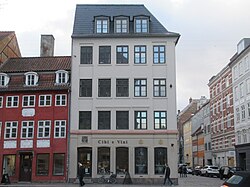
The Rhode House is a historic property located at the corner of Strandgade and Torvegade in the Christianshavn neighbourhood of central Copenhagen, Denmark.

Sværtegade 3 is a listed property in the Old Town of Copenhagen, Denmark, consisting of a four-storey building from the 18th century fronting the street and a large, three-winged building from 1829 in the courtyard. J. G Schwart & Søn was from 1806 to 1983 based at the site. The entire complex was listed on the Danish registry of protected buildings and places in 1918. Harald Conrad Stilling's shop facade and interior from 1847 is part of the heritage listing.

Løvstræde 14 is a Neoclassical property situated at the corner of Gråbrødretorv and Løvstræde in the Old Town of Copenhagen, Denmark. It originates in a three-storey corner building from around 1730 but owes its current appearance to an 1832 renovation and extension along Løvstræde. The entire complex was listed in the Danish registry of protected buildings and places in 1950.
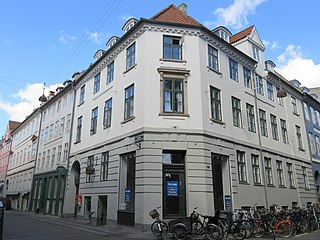
Kompagnistræde 10 is a Neoclassical property situated at the corner of Kompagnistræde and Badstuestræde in the Old Town of Copenhagen, Denmark. A bakery was operated on the site from at least the 17th century until the late 19th century. Like many of the other buildings in the area, the current building was constructed as part of the rebuilding of the city following the Copenhagen Fire of 1795. A gilded relief of a kringle above a door in the courtyard bears testament to the former use of the property. The entire complex was listed in the Danish registry of protected buildings and places in 1949. Former residents include orientalist Carl Theodor Johannsen and composer Christian Julius Hansen.

Kompagnistræde 9 is a property situated on Strædet, between Naboløs and Knabrostræde, roughly opposite Badstuestræde, in the Old Town of Copenhagen, Denmark. Like most of the other buildings in the area, the building was constructed as part of the rebuilding of the city following the Copenhagen Fire of 1795. It was listed in the Danish registry of protected buildings and places in 1945.

Brolæggerstræde 4 is a Neoclassical property situated in the Old Town of Copenhagen, Denmark. Like most of the other buildings in the area, it was constructed as part of the rebuilding of the city following the Copenhagen Fire of 1795. The three-winged complex was listed in the Danish registry of protected buildings and places in 1950.
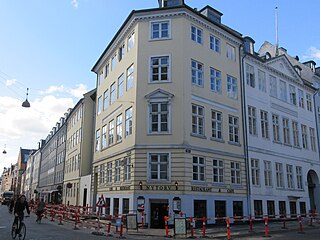
Nytorv 15/Rådhusstræde 2 is a Neoclassical property situated at the corner of Nytorv and Rådhusstræde in the Old Town of Copenhagen, Denmark. It consists of two separate buildings, the corner building from 1797 and an eight-bay building from 1798, now connected by a narrow modern infill. The building was listed in the Danish registry of protected buildings and places in 1945. Notable former residents include jurist, writer and publisher Jacob Just Gudenrath (1657–1825), actors Stephan and Eline Heger, theatrical painter Edvard Lehmann and portrait painter hristian Frederik Christensen (1805-1883).

Vestergade 15 is a Neoclassical property situated at the corner of Vestergade and Kattesundet in central Copenhagen, Denmark. The building was listed in the Danish registry of protected buildings and places in 1918. Notable former residents include the Icelandic-Danish lawyer Brynjólfur Pétursson.

Kringlegangen is a passageway linking the square Gråbrødretorv with the street Valkendorfsgade in the Old Town of Copenhagen, Denmark. A bakery was operated on the site from before 1787 until at least the 1910s. The present building complex was constructed in 1856-1857 for master joiner Carl Heinrich Winther. The passageway was not opened to the public until 1975. The name Kringlegangen was inspired by a gilded kringle above the entrance from Gråbrødretorv as well as to the twisting and turning course of the passageway. The entire building complex was listed in the Danish registry of protected buildings and places in 1945.

Kompagnistræde 24 is a Neoclassical property situated on Strædet, between Knabrostræde and R¨dhusstræde, in the Old Town of Copenhagen, Denmark. It was constructed as part of the rebuilding of the city following the Copenhagen Fire of 1795 and later heightened with one storey in 1849. The building was listed in the Danish registry of protected buildings and places in 1979. Notable former residents include the artist Janus Laurentius Ridter.

Sankt Annæ Gade 20–22 is a complex of Neoclassical buildings situated at the corner of Sankt Annæ Gade and Christianshavns Kanal in the Christianshavn neighborhood of central Copenhagen, Denmark. A distillery was for more than one hundred years—from at least the 1750s until at least the 1860s— operated on the site. The current complex consists of a corner building from 1804, flanked by two just two-bays-wide older buildings, both of which were adapted in connection with the construction of the corner building. The entire complex was jointly listed in the Danish registry of protected buildings and places in 1950. The courtyard on the rear was redesigned by landscape architect Jeppe Aagaard Andersen in the 1980s.

Torvegade 22 is an 18th-century property situated on Torvegade in the Christianshavn neighborhood of central Copenhagen, Denmark. The building was from its construction in 1714 to 1902 owned by bakers and the site of one of two bakeries in the street. A gilded kringle can still be seen above the main entrance. The other bakery was situated a little further down the street at Torvegade 28. The building was listed in the Danish registry of protected buildings and places in 1950.

Strandgade 30 is one of the oldest townhouses situated on Strandgade in the Christianshavn district of central Copenhagen, Denmark. The three-winged building from 1635 is via an adjoining lower building from the 20th century and a three-storey warehouse connected to a two-storey building at Wildersgade 43 on the other side of the block. The property was from 1680 until at least the 1860s owned by brewers whose brewery was located in the yard. The painter Wilhelm Hammershøi resided in the apartment on the first floor from 1899 to 1909. Some 60 of the 142 paintings from this period of his life, including some of his most iconic works, are interior paintings from the apartment. Other notable former residents include the ship-owner, merchant and slave trader Jens Lind. A doorway in a brick wall connects the narrow, central courtyard to that of Strandgade 28. Strandgade 30 and Strandgade 28 were owned by the same owners from 1910. They were jointly listed in the Danish registry of protected buildings and places in 1918. The building at Wildersgade 43 and the adjacent warehouse in the courtyard are also part of the heritage listing.

The Sigvert Grubbe House is a Renaissance style townhouse situated at Strandgade 28 in the Chrstianshavn neighborhood of central Copenhagen, Denmark. The property comprises the building at Wildersgade 41 on the other side of the block as well as a half-timbered building separating two central courtyards from each other. The apartment on the first floor features a number of murals attributed to Nicolai Abildgaard. The entire complex was listed in the Danish registry of protected buildings and places in 1918. It takes its name after its first owner, Sigbert Grubbe, a favourite of ChristianIV. It was later owned by Jacob Benjamin Italiaender, a Sphardi Jew, who established a tobacco manufactory as well as a private sunagogue in the yard. The painter Peder Severin Krøyer grew up in the building in the 1860s.
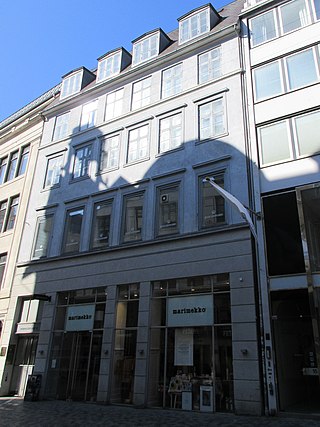
Købmagergade 13 is an 18th-century townhouse situated on the shopping street Købmagergade, between Amagertorv and Valkendorfsgade, in central Copenhagen, Denmark. It was listed in the Danish registry of protected buildings and places in 1974. The complex consists of a four-storey building towards the street, two consecutive, half-timbered side wings along one side of a courtyard, a cross wing, separating the first and second courtyard from each other,, another half-timbered side wing along one side of the second courtyard, and two rear wings. Notable former residents include the businessmen Peter Pierre Tutein, Friederich Tutein and Peter van Gemmert, book printer Andreas Seidelin, educator Jens Ernst Wegener and architect Gottlieb Bindesbøll.

Lille Strandstræde 8 is an 18th-century property situated around the corner from Nyhavn in central Copenhagen, Denmark. Constructed as a two-storey, half-timbered building for Andreas Bodenhoff in the middle of the century, it was later first reconstructed in brick and heightened with two storeys in 1783 and then, in 1932, expanded with a seven-bays-long side wing on the rear. The building was listed in the Danish registry of protected buildings and places in 1959. Notable former residents include the German painter Bernhard Mohrhagen and the veterinarian Viggo Stockfleth.
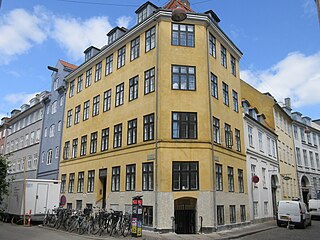
Knabrostræde 25 is an 1830s apartment building situated at the slightly acute-angled corner of Knabrostræde and Snaregade, close to Gammel Strand, in the Old Town of Copenhagen,, Denmark. It was listed in the Danish registry of protected buildings and places in 1945.

The Gerling House is a late 17th-century hibuilding complex complex situated at Strandgade 38 in the Christianshavn district of central Copenhagen, Denmark. It consists of a three-storey, four-bays-wide front wing towards the street and a 13-bays-long two-storey side wing on its rear. The master cooper Peter Richter established a cooper's workshop in the building in the 1830s and the property was after his death owned by his widow until 1880. The building was listed in the Danish registry of protected buildings and places in 1918. Notable former residents include the naval officer and painter Sophus Schack.
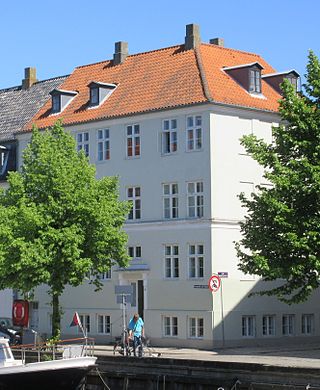
Overgaden Oven Vamdet 8 is an 18th-century building overlooking Christianshavn Canal in the Christianshavn neighbourhood of central Copenhagen, Denmark. It originates in a two-storey, Neoclassical building constructed in 1786 by Andreas Kirkerup for candle maker Christian From. This building was heightened with one storey in 1831. It was listed in the Danish registry of protected buildings and places in 1945. Notable former residents include organist and composer Niels Peter Hillebrandt.
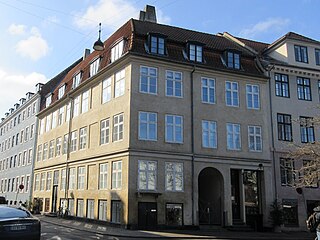
Lille Strandstræde 13–15 is a property situated at the corner of Lille Strandstræde and the small nameless square that is formed where the street joins Store Strandstræde on the south side of Sankt Annæ Plads in central Copenhagen, Denmark. The corner property was from at least the 1750s to circa 1890 owned by distillers. Their distillery was located on the upper floors of a still existing warehouse in the courtyard. The ground floor of the warehouse was used as cow stable. Part of the building fronting the street was also used by the distillery. No. 13 dates from 1852. No. 15 dates from 1758 but was refurbished in 1852. The entire complex was listed in the Danish registry of protected buildings and places in 1950. In front of the building is a small garden complex with a bronze cast of Otto Evens's 1859 statue Neapolitan Fisherman Teaches His Son to Play the Flute.
